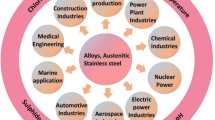An electron microscope analysis of the surface of deposited copper is performed after a profiling-piercing electroerosion treatment. The deposited copper is treated with steel, duralumin, and copper electrode tools at different pulse energies. The treatment with the duralumin electrode produces on the treated surface a web-like structure and cubic-morphology polyhedral dimples about 10 μm in size. The main components of the surface treated with the steel electrode are developed polyhedral dimples with a size of 10 – 50 μm. After the treatment with the copper electrode the main components of the treated surface are large polyhedral dimples about 30 – 80 μm in size.





Similar content being viewed by others
Notes
The authors gratefully acknowledge the help with construction and analysis of the 3D-models rendered by a postgraduate student of the chair of Metal Science and Heat Treatment (PNIPU) G. S. Shaimanov.
References
A. D. Verkhoturov, “Generalized model of the process of electrospark alloying,” Elektrofiz. Elektrokhim. Metody Obrab., No. 1, 3 – 5 (1983).
B. N. Zolotykh, Basic Physics of Electrophysical and Electrochemical Methods of Treatment [in Russian], MIÉM, Moscow (1975), 104 p.
B. N. Zolotykh, Basic Physics of Electrospark Treatment of Metals [in Russian], Gostekhteoretizdat, Moscow (1953), 107 p.
N. K. Foteev, “Quality of surface after electroerosion treatment,” STIM, No. 8, 43 – 48 (1997).
V. S. Kovalenko, Laser and Electroerosion Hardening of Materials [in Russian], Nauka, Moscow (1986), 276 p.
M. Yu. Simonov, G. S. Shaimanov, and Yu. N. Simonov, “Formation of zones of plastic strain in quenched and tempered steel 09G2S during dynamic tests,” Metal Sci. Heat. Treat., 57(11 – 12), 746 – 751 (2016).
M. Yu. Simonov, M. N. Georgiev, Yu. N. Simonov, and G. S. Shaimanov, “Assessment of the sizes of plastic strain zone in high-toughness materials after dynamic tests by the method of systematic measurement of microhardness,” Metalloved. Term. Obrab. Met., No. 11, 40 – 45 (2012).
M. Yu. Simonov, M. N. Georgiev, G. S. Shaimanov, et al., “Comparative analysis of zones of plastic strain, dynamic crack resistance, structure and micromechanisms of crack propagation in steels 09G2S, 25 and 40 in high-toughness condition,” Metalloved. Term. Obrab. Met., No. 2, 39 – 48 (2018).
L. Ya. Popilov, Electrophysical and Electrochemical Treatment of Materials [in Russian], Mashinostroenie, Moscow (1982), 400 p.
V. B. Vitlin and A. S. Davydov, Electrophysical Methods of Treatment in the Metallurgical Production [in Russian], Metallurgiya, Moscow (1979), 157 p.
V. V. Ploshkin, Structural and Phase Transformations in Surface Layers of Steels under Electroerosion Treatment, Author’s Abstract of Candidate’s Thesis [in Russian], Moscow (2006), 281 p.
A. S. Arakelyan, R. M. Shamsutdinov, and T. R. Ablyaz, “Raising the process possibilities of electroerosion mills,” Sovr. Prob. Nauki Obraz., No. 2 (2014).
S. Dey and D. C. Roy, “Experimental study using different tools,” Int. J. Modern Eng. Res. (IJMER), 3(3), 1263 – 1267 (2013).
P. Janmanee and A. Muttamara, “Performance of difference electrode materials in electrical discharge machining of tungsten carbide,” Energy Res. J., No. 1(2), 87 – 90 (2010).
H. Tsai, “The properties and characteristics of the new electrodes based on Cr-Cu for EDM machines,” Int. J. Mach. Tools Manuf., 43(3), 245 – 252 (2003).
H. Liu, Y. Yang, S. Shen, et al., “Performance and microstructure of TiN_Cu EDM electrodes,” Appl. Mechan. Mater., 268 – 270, 82 – 86 (2012).
I. N. Potapov, V. N. Lebedev, and A. G. Kobelev, Layered Metallic Compositions [in Russian], Metallurgiya, Moscow (1986), 216 p.
L. P. Glukhikh and V. I. Kozlov, “Special features of the structure of two-layer steel 22K+08Kh18N10T after thermomechanical treatment,” Metalloved. Term. Obrab. Met., No. 10, 45 – 47 (1982).
R. P. Todorov, Bimetallic Contacts [in Russian], Metallurgiya, Moscow (1976), 88 p.
V. A. Makovskii and L. S. Eil’man, Bimetallic Bars [in Russian], Metallurgiya, Moscow (1981), 180 p.
S. D. Neulybin, Yu. D. Shchitsyn, P. S. Kuchev, and I. A. Gilev, “Plasma treatment of copper on steel under reversed polarity current,” Izv. Samarsk. Nauch. Tsentra Ross. Akad. Nauk, 16[1(2)], 468 – 471 (2014).
M. Yu. Simonov, G. S. Shaimanov, A. S. Pertsev, et al., “Effect of structure on the dynamic crack resistance and special features the micromechanism of crack growth in steel 35Kh after cold radial forging,” Metalloved. Term. Obrab. Met., No. 2, 24 – 32 (2016).
Ya. E. Geguzin, The Physics of Sintering [in Russian], Nauka, Moscow (1984), 312 p.
The work has been performed with financial support of the Ministry of Education and Science of the Russian Federation within State Specification 11.9716.2017/8.9.
Author information
Authors and Affiliations
Corresponding author
Additional information
Translated from Metallovedenie i Termicheskaya Obrabotka Metallov, No. 12, pp. 37 – 43, December, 2017.
Rights and permissions
About this article
Cite this article
Ablyaz, T.R., Simonov, M.Y. & Shlykov, E.S. Analysis of the Surface of Deposited Copper After Electroerosion Treatment. Met Sci Heat Treat 59, 779–785 (2018). https://doi.org/10.1007/s11041-018-0226-1
Published:
Issue Date:
DOI: https://doi.org/10.1007/s11041-018-0226-1




